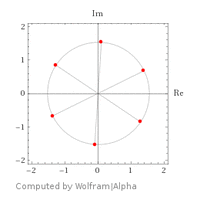pka
Elite Member
- Joined
- Jan 29, 2005
- Messages
- 11,976
There are six sixth roots of \(\displaystyle -12+5i\) see here.
 See that there are six of them. Each of them is on a circle centered at the origin of radius \(\displaystyle |-12+5i|^{1/6}=\large\sqrt[6]{13}\)
See that there are six of them. Each of them is on a circle centered at the origin of radius \(\displaystyle |-12+5i|^{1/6}=\large\sqrt[6]{13}\)
However, the salient feature is the fact the the are evenly spaced on the circle and the central angle between any to adjacent is \(\displaystyle \frac{2\pi}{6}=\frac{\pi}{3}\). see here
Here is a step by step outline: If \(\displaystyle N>1\) is a positive integer and \(\displaystyle z=x+yi\) is a complex number in which \(\displaystyle x\cdot y\ne 0\) (if that case fails there are special considerations).
Because all of this necessitates \(\displaystyle z\) being in polar form, I digress into this:
\(\displaystyle \arg(z)=\arg(x + yi) = \left\{ {\begin{array}{{rl}} {\arctan \left( {\dfrac{y}{x}} \right),}&{x > 0} \\ {\arctan \left( {\dfrac{y}{x}} \right) + \pi ,}&{x < 0\;\& \;y > 0} \\ {\arctan \left( {\dfrac{y}{x}} \right) - \pi ,}&{x < 0\;\& \;y < 0} \end{array}} \right. \) _______keep in mind that \(\displaystyle x\cdot y\ne 0 \text{ implies }x\ne 0~\&~y\ne 0\).
Return to the job at hand. If \(\displaystyle z=|z|\exp(\theta i)\) where \(\displaystyle \theta=\arg(z)\)
Define \(\displaystyle \zeta={\large\sqrt[N]{|z|}}\exp\left(\frac{\theta i}{N}\right)\) _____Do you see that \(\displaystyle \zeta^N=z~?\) I certainly hope you do !
Now we need a "rotator " to distribute the roots of \(\displaystyle z\) equality spaced around a circle. \(\displaystyle \rho=\exp\left(\frac{2\pi i}{N}\right)\)
The set \(\displaystyle \left\{\zeta\cdot\rho^k|k=0,1,\cdots N-1 \right\}\) is the collection of the \(\displaystyle N^{th}\) roots of \(\displaystyle z\).
Here is a practice question: List the seven seventh roots of \(\displaystyle -6-8i\).
 See that there are six of them. Each of them is on a circle centered at the origin of radius \(\displaystyle |-12+5i|^{1/6}=\large\sqrt[6]{13}\)
See that there are six of them. Each of them is on a circle centered at the origin of radius \(\displaystyle |-12+5i|^{1/6}=\large\sqrt[6]{13}\)However, the salient feature is the fact the the are evenly spaced on the circle and the central angle between any to adjacent is \(\displaystyle \frac{2\pi}{6}=\frac{\pi}{3}\). see here
Here is a step by step outline: If \(\displaystyle N>1\) is a positive integer and \(\displaystyle z=x+yi\) is a complex number in which \(\displaystyle x\cdot y\ne 0\) (if that case fails there are special considerations).
Because all of this necessitates \(\displaystyle z\) being in polar form, I digress into this:
\(\displaystyle \arg(z)=\arg(x + yi) = \left\{ {\begin{array}{{rl}} {\arctan \left( {\dfrac{y}{x}} \right),}&{x > 0} \\ {\arctan \left( {\dfrac{y}{x}} \right) + \pi ,}&{x < 0\;\& \;y > 0} \\ {\arctan \left( {\dfrac{y}{x}} \right) - \pi ,}&{x < 0\;\& \;y < 0} \end{array}} \right. \) _______keep in mind that \(\displaystyle x\cdot y\ne 0 \text{ implies }x\ne 0~\&~y\ne 0\).
Return to the job at hand. If \(\displaystyle z=|z|\exp(\theta i)\) where \(\displaystyle \theta=\arg(z)\)
Define \(\displaystyle \zeta={\large\sqrt[N]{|z|}}\exp\left(\frac{\theta i}{N}\right)\) _____Do you see that \(\displaystyle \zeta^N=z~?\) I certainly hope you do !
Now we need a "rotator " to distribute the roots of \(\displaystyle z\) equality spaced around a circle. \(\displaystyle \rho=\exp\left(\frac{2\pi i}{N}\right)\)
The set \(\displaystyle \left\{\zeta\cdot\rho^k|k=0,1,\cdots N-1 \right\}\) is the collection of the \(\displaystyle N^{th}\) roots of \(\displaystyle z\).
Here is a practice question: List the seven seventh roots of \(\displaystyle -6-8i\).
